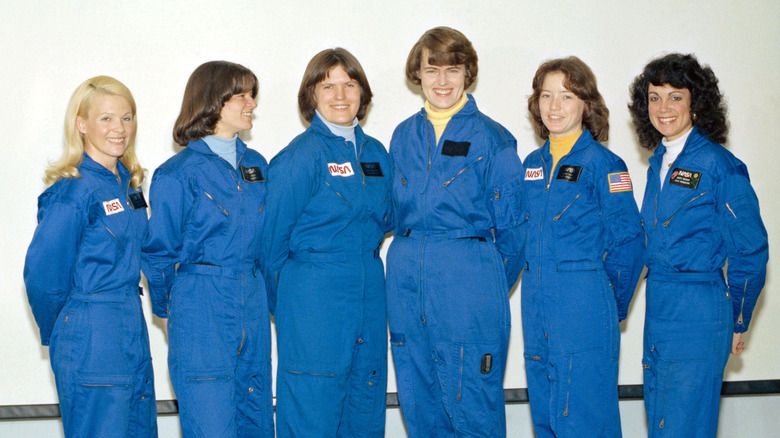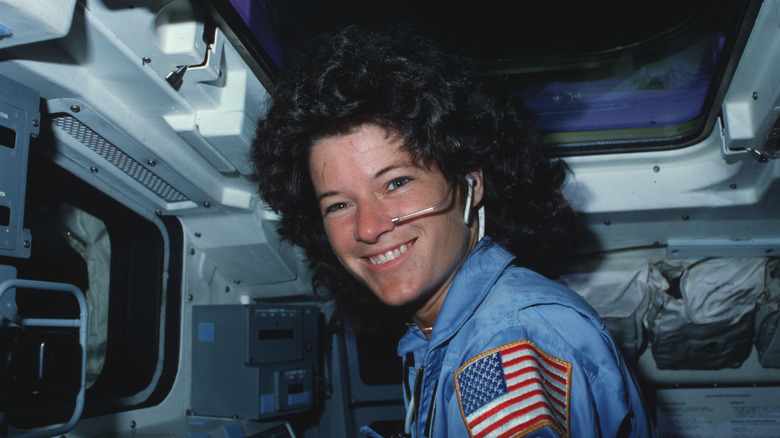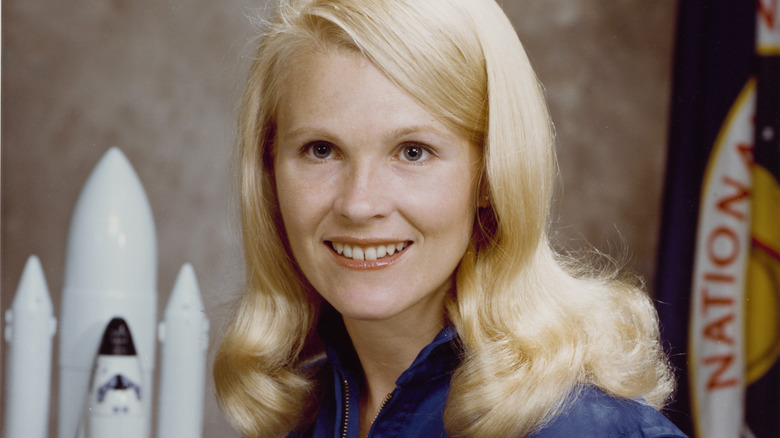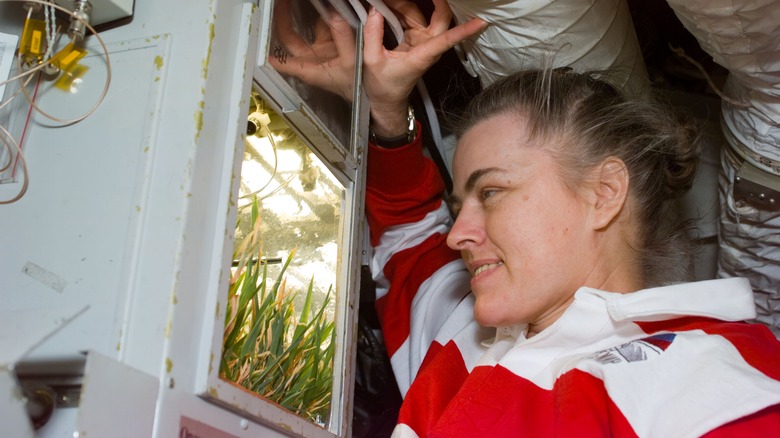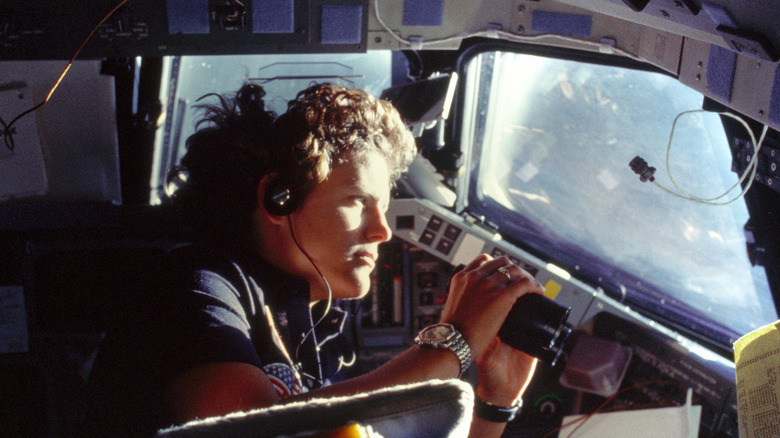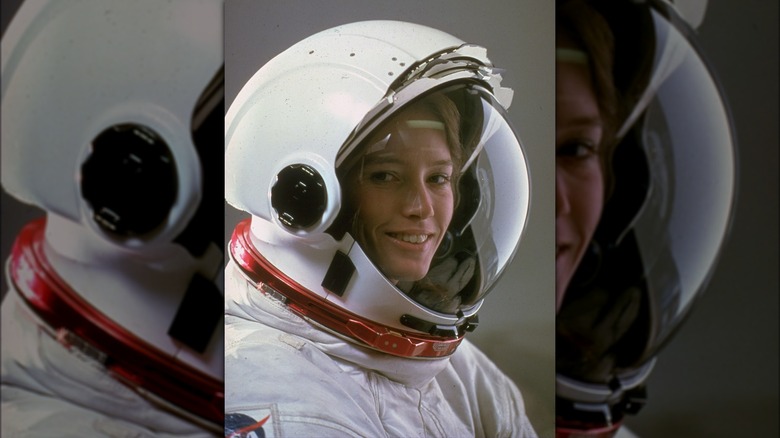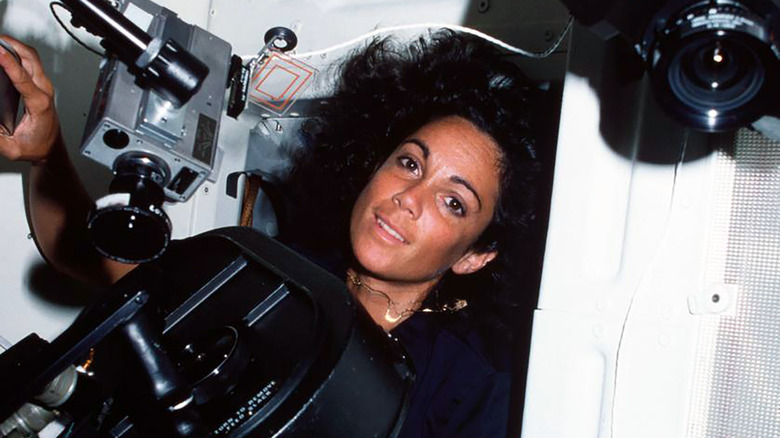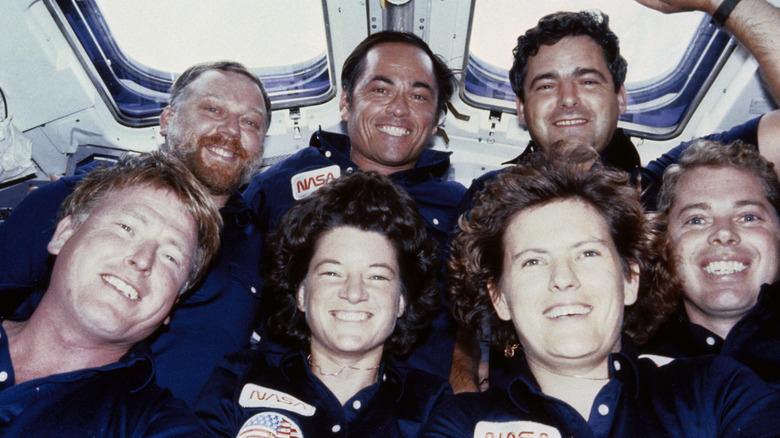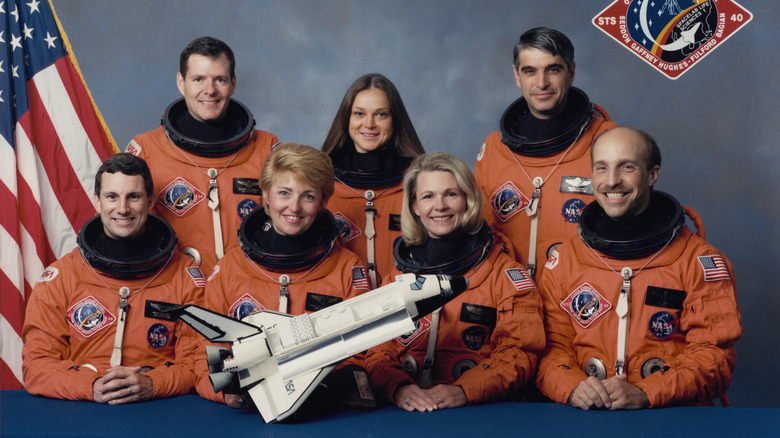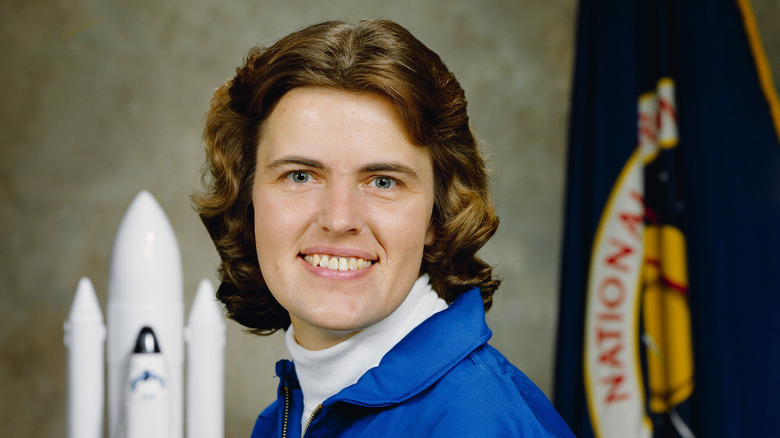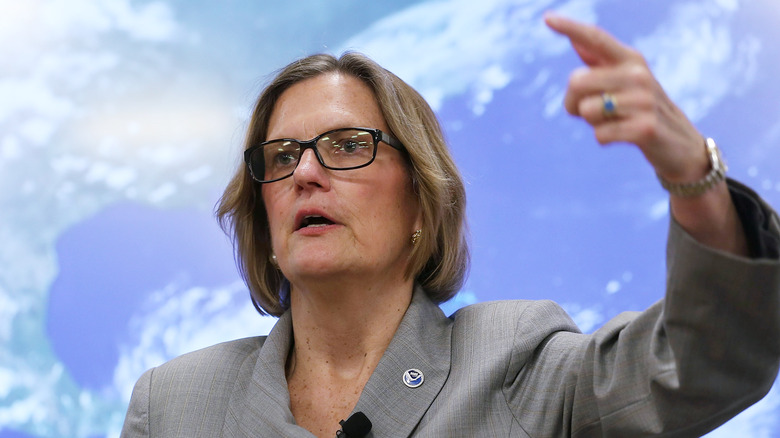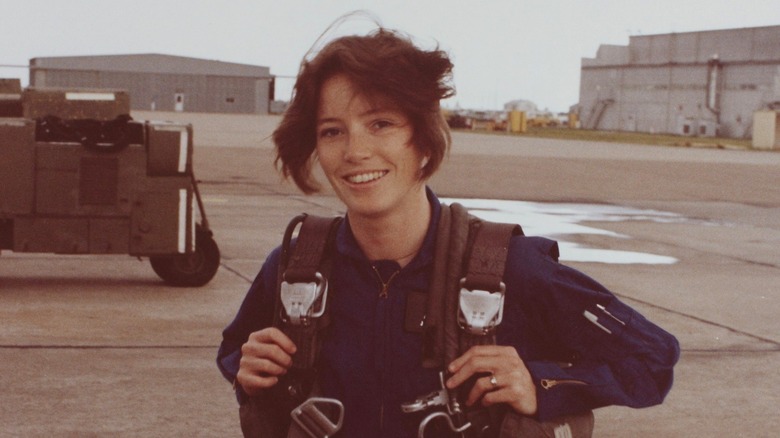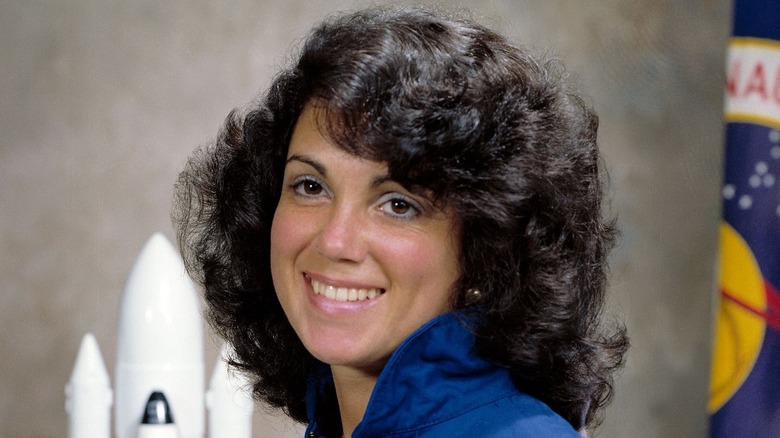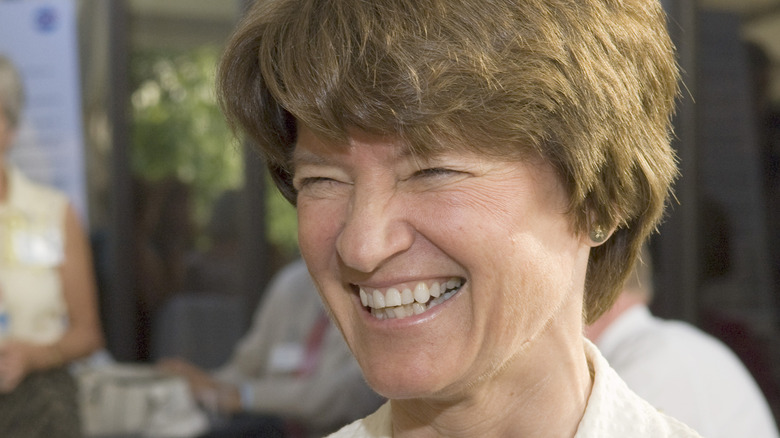The Untold Truth Of NASA's First Six Female Astronauts
Ever since Yuri Gagarin became the first human to enter Earth's orbit in 1961, generations of people have grown up aspiring to become astronauts. From our modern perspective, though, it can be easy to forget that the dawn of space travel happened during a much more chauvinistic world. In its early days, NASA's crews were exclusively male. It wasn't until 1978, per Space.com, that NASA recruited its first female astronauts, a full 20 years after the agency was first established. NASA's call for more diverse recruits garnered over 20,000 applications, 1,142 of whom were women. Just six were chosen — Sally Ride, Judy Resnik, Anna Fisher, Kathy Sullivan, Shannon Lucid, and Rhea Seddon. Each was already a remarkable individual long before NASA knew who they were.
They were part of NASA's Astronaut Group 8, a batch of recruits who gained the nickname of TFNG. This moniker officially stood for the name "Thirty-Five New Guys," ironic considering not all of them were guys. Off the record though, this name had a rather more derogatory meaning. It came from military slang, meaning "the f**king new guy," betraying exactly how they were regarded by many of the previous spacefarers. Up until that point, NASA astronaut groups had mostly been test pilots from the Navy and Air Force, while many of the new arrivals were civilians. As NASA entered a new era, the class of '78 was the first astronaut group not to be made up exclusively of white men with military haircuts.
Sally Ride was nearly a tennis player
Sally Ride was very nearly not an astronaut at all. Her earliest passion was for tennis. Even though she would ultimately choose a grander career, it's no exaggeration to say that tennis shaped her life as much as NASA eventually would. Even as a veteran spacefarer, in an Academy of Achievement interview, she described the appearance of Earth's atmosphere from space as being "about as thick as the fuzz on a tennis ball."
After her first tennis lesson at the age of 9, per the National Air and Space Museum, her skill and passion for the sport helped her win a private school scholarship. By the time she became an undergraduate student, she was a nationally ranked player. Ride aspired to play professionally, but that dream wasn't to be. As the book "Sally Ride: America's First Woman in Space" mentions, she realized in college that she didn't have the discipline for the sport's extreme physical demands. Ironic, considering the career she would end up in.
Tennis was also deeply important to Ride in another big way. It was how she met the love of her life. Pro tennis player Tam O'Shaughnessy would eventually become Ride's romantic partner for 27 years. The two were childhood friends, and they got to know each other on the tennis court. O'Shaughnessy later reminisced on NPR's "Short Wave" podcast, that it was when both were in their 30s that they realized they were in love.
Rhea Seddon had difficulty because of her height
Until the class of '78, everything about the space program had been designed with military men in mind, and this caused difficulty for some of the new recruits. Standing at 5 feet 2 inches, Rhea Seddon was the shortest astronaut NASA had ever enrolled at the time. While she was two inches taller than the specified height minimum, NASA had simply not been designed for someone her size. In her book, "Go For Orbit" (via the National Space Society), she later wrote, "I soon learned that my biggest problem as an astronaut was not being female: it was being small."
In an interview with the Johnson Space Center Oral History Project, Seddon described how a lot of equipment had clearly been made for people with a minimum height of around 5'6, but setting that as a required minimum would've disqualified a huge number of women from even applying. While it wouldn't be a problem while in orbit, the cargo bay window in the space shuttle cockpit was so high off the ground that, while on Earth, she couldn't see through it without standing on something.
While she did her best to simply work around the problems, sometimes Seddon's smaller-than-expected stature was potentially hazardous. Her training required her to pilot a T-38 jet trainer. Not only was the step to enter the cockpit at waist height for her, but her shoulders were too narrow for even the smallest available parachute.
Shannon Lucid was the only volunteer to stay on Mir
In the 1970s, the U.S. and the Soviet Union began to work together in spaceflight for the first time. Beginning with the Apollo-Soyuz Mission in 1975, this partnership would continue even after the USSR fell. The Mir space station was launched in the Soviet Union's final years, in 1986, and would eventually be visited by both Russian cosmonauts and American astronauts alike. By the time the Shuttle-Mir Program began in the mid-'90s, Shannon Lucid was a veteran spacefarer, and she would soon become one of the first Americans to spend time living in space.
In 1996, Lucid spent four and a half months living aboard the Mir space station, setting a new NASA spaceflight record in the process. While she wasn't the first American to make the trip, it was still a hard sell among her colleagues. Staying on Mir involved learning Russian and then spending a year living in Russia's Star City for an intense training regimen. Volunteers were few, but Lucid had already been considering what the experience would be like. In an interview with CNN, she later mentioned, "I told everybody I wanted to do it, and they couldn't find anybody else who had volunteered."
Fortunately for Lucid, while her training was arduous, she got on well with her cosmonaut roommates. By this point, she'd flown into space on four shuttle missions already, making the actual space travel one of the easiest parts for her.
Kathy Sullivan also visited the deep sea
Kathy Sullivan is certainly a pioneer. Aboard the space shuttle on mission STS-41G, she became the first American woman to do a spacewalk — technically known as an extra-vehicular activity or EVA. This would also be the first time two women would make the trip into orbit at the same time, with Sally Ride being one of Sullivan's crewmates on the space shuttle Challenger.
In 2020, however, Sullivan became a member of an even more select group than astronauts. As the New York Times reported, she visited the Challenger Deep. This is the deepest, darkest trench in Earth's oceans, and a place only ever visited by a handful of people. At the time, Sullivan was one of only eight to ever make the journey, and the first woman to do so. As well as being an astronaut, Sullivan is also an oceanographer, so the experience held special significance for her. She recounted how her deep-sea journey was "a once in a lifetime day, seeing the moonscape of the Challenger Deep and then comparing notes with my colleagues on the ISS" — after their voyage, the submersible crew spoke directly with the crew of astronauts aboard the International Space Station at the time. In Sullivan's own words, per ABC News, "It highlighted the vast span of human endeavor while at the same time linking us close together as fellow explorers."
Anna Fisher became a pop culture icon
Anna Fisher is now probably most famous for an iconic black and white photograph of her wearing a space helmet. In 1983, photographer John Bryson did a whole photoshoot with her fully suited up in astronaut attire. One photograph in particular, as Fusion Magazine explains, became widely recognized. Showing Fisher almost in side profile, looking out in wonder, the photograph echoes a scene in the movie Alien, released a few years earlier, showing protagonist Ellen Ripley with a similar helmet and pose.
Her iconic photo is now widely shared on the internet, regularly appearing on sites like Reddit and Tumblr. It's been remixed and referenced extensively in pop culture, including in music promo posters for bands like Incubus and the Arctic Monkeys. Per UCLA, her alma mater, 1983 was the same year that Fisher was assigned to her first space mission on the space shuttle Discovery. This was also just two weeks before she gave birth to her daughter, meaning that when she traveled to orbit in 1984, she was the first mother to go into space.
Judy Resnik could have been a concert pianist
Judy Resnik was the kind of person who wanted to try everything, which is no doubt what prompted her to apply to become an astronaut. While it was NASA that made her famous though, this was neither her first nor her only ambition. During her life, Resnik was determined to do as many different things as she possibly could, and among her many talents, she was trained as a classical pianist.
Per Australia's Engineering Institute of Technology, her earliest aspiration was to be a concert pianist. Growing up in Akron, Ohio, she didn't just take piano lessons but studied with two famous local musicians, Arthur Reginald and Pat Pace. Both were enthusiastic about Resnik's musical talent and her potential to be a professional musician. Resnik eventually chose not to pursue music, finding her career as an astronaut — though, perhaps it's more accurate to say that this career found her. As she mentioned in an interview with the TV show "Today" (via YouTube), when she requested an application pack from NASA, it was purely on a whim.
Sally Ride was the second woman to go to space twice
Sally Ride's return to orbit was in 1984 on the Challenger space shuttle, together with Kathy Sullivan. In so doing, she became the first American woman to take such a second journey. During the mission, she also paid a quiet tribute to another of America's great pioneering women. On her journey, she carried a white silk scarf previously owned by Amelia Earhart, the first American woman to fly solo across the Atlantic Ocean.
The first woman in history to make two spaceflights was Russian cosmonaut Svetlana Savitskaya, aboard the Soyuz T-12 mission a few months prior, in December of 1983. As well as making a second spaceflight, Savitskaya was also the first woman to perform a spacewalk. At the time though, Ride and Savitskaya were already acquainted. In September 1983, per the book "Sally Ride: America's First Woman in Space," completely of her own accord, Ride had arranged to meet up with Savitskaya in Budapest. At the time, the U.S. and U.S.S.R. were still officially rivals, so their meeting had to be kept low-key. All the same, the two had an immediate connection, thanks to the similar experience both had been through, enjoying a long conversation and exchanging a variety of gifts like Russian dolls and space shuttle charms. Ride later explained, "We felt a real kinship, a real affinity for each other. I felt closer to her than I'd felt to anyone in a very long time."
Rhea Seddon worked with more women as an astronaut than as a doctor
When NASA hired their class of '78, they made their selections for two main roles — as pilots, and as mission specialists. For her academic qualifications, Rhea Seddon was chosen as a specialist, but she was also a pilot before she was recruited. After finishing medical school, her father bought her flying lessons as a graduation present. While women astronauts were still unheard of at the time, women doctors were also a rarity.
Being one of NASA's first six female astronauts was the second time Seddon was one of only six women in a professional setting. At medical school, her class had 100 students, just six of whom were women. After she graduated, Seddon was admitted into a surgical residency program in Memphis. She was the first woman ever to be accepted by the program, and the only woman in the otherwise all-male staff. Shocking as it may seem, she had more female colleagues after being recruited by NASA.
Shannon Lucid snubbed Saudi Arabia
During Shannon Lucid's first spaceflight, she was traveling with royalty. Joining her on the crew of shuttle mission STS-51G was Sultan bin Salman Al Saud, an air force pilot and prince of Saudi Arabia. At the time, shuttle missions were followed by press tours, but this one would prove to be complicated for Lucid.
After the spaceflight, she was invited to Saudi Arabia to meet King Fahd — a prospect she didn't relish because of the country's strongly patriarchal values. Her husband was unavailable to join her for the journey, which she didn't think much of at the time — until she discovered that as a woman, she wasn't even allowed to enter the country without a male escort. Learning this, she informed NASA that she wouldn't be going. The publicity tour went ahead without Lucid, but her absence was conspicuous, leading Fahd to make a phone call directly to President Ronald Reagan about it. Lucid eventually relented and agreed to make the journey. According to the National Space Society, she had to be officially declared an "honorary man" to be able to accept Fahd's invitation and enter the country. Lucid traveled to Saudi Arabia, shook hands with the king, and then immediately left to return home.
Kathy Sullivan became Administrator for NOAA
As well as being part of NASA's first group of female astronauts, Kathy Sullivan holds another accolade. She was one of the first women allowed to join the esteemed Explorers Club, an organization promoting scientific exploration. She was admitted in 1981, together with Sylvia Earle, who would go on to be the first woman to become chief scientist at NOAA, America's National Oceanic and Atmospheric Administration.
Earle worked as chief scientist from 1990 to 1992. When she stepped down, Sullivan was invited to take over the role. The ocean had always been Sullivan's true passion. In college, she'd studied oceanography and always had a particular love of fieldwork exploring the sea. For a while, she'd worried that becoming an astronaut might prevent her from any potential future as an oceanographer. Instead, she managed to earn an illustrious career in both. Per the White House, during Barack Obama's presidency, Sullivan served as the NOAA Administrator and ran the agency.
Anna Fisher met her astronaut husband before either worked for NASA
Lots of people meet their spouses through work, and that's as true of astronauts as it is of those in almost any other profession. Astronaut couples are now quite well known at NASA. While some meet during their astronaut training, Anna Fisher and her former husband were already engaged before either had even applied for the job. They'd met while they were interns at Harbor General Hospital in Los Angeles, but both had aspired since childhood to become astronauts.
Per the Johnson Space Center Oral History Project, it was Bill Fisher who first learned that NASA had vacancies open. A mutual friend of theirs had met him for lunch, saying, "Hey, NASA is looking for people. You and Anna have always talked about how you're interested." With just three weeks before the deadline, the two managed to send their applications off just in time. While Anna was accepted though, Bill was initially rejected. He applied again later on and was accepted into Astronaut Group 9. Where Anna had been a year behind as a medical intern, she ended up being a year ahead as an astronaut.
Judy Resnick was almost the first American woman in space
Judy Resnik was quite outgoing and had a reputation for being excellent company. In an interview for the Johnson Space Center Oral History Project, Rhea Seddon described her as "A very beautiful person, flirtatious, funny. She was just a live wire." As training started to come to an end, everyone's mind was on who NASA would choose to be America's first woman in space. Most expected it would either be Resnik or Sally Ride.
Resnik though, while outgoing with her friends and colleagues, famously hated the press. The book "Women in Space – Following Valentina" notes that she was irritated by the excessive attention, considering it unfair that she was put in the spotlight just for being a woman. It was one of her first impressions of being an astronaut, after receiving over 100 interview requests immediately after she'd first been selected.
NASA is famously (or perhaps infamously) secretive about why it makes the decisions it does — Ride has mentioned that she never knew exactly why she was chosen to be first — but Resnik's aversion to publicity may have been part of the reason. It's likely that the director of flight operations believed Ride would be better able to handle the media pressure. After it was announced that Ride would be traveling first, the press responded by asking her exactly the kind of demeaning and invasive questions that Resnik would have no doubt despised.
Sally Ride turned down the NASA Administrator job twice
Aside from her time as an astronaut, Sally Ride went on to have an influential career with NASA. Following the tragic Challenger disaster that caused the tragic deaths of seven astronauts, including Judy Resnik, Ride was heavily involved in the following investigation. When the task was completed, she continued to work in NASA administration, being assigned as special assistant to the administrator for long-range and strategic planning at NASA HQ. One of her big accomplishments in the role was writing and publishing a major report titled "NASA Leadership and America's Future in Space."
While Ride certainly had both the potential and the experience to take the reins and run NASA though, she never accepted the role — and not for lack of opportunities. Even after Ride officially left NASA in 1987, she still received job offers there, most notably for the position of NASA Administrator. Two U.S. presidents, Bill Clinton and Barack Obama, both offered her the illustrious leading role for the space agency. Both times, she declined. Once, when asked what it would take for her to accept the job, she said simply, "If they'd move it to California."
[Featured image by NASA Goddard Space Flight Center via Flickr | Cropped and scaled | CC BY 2.0]
